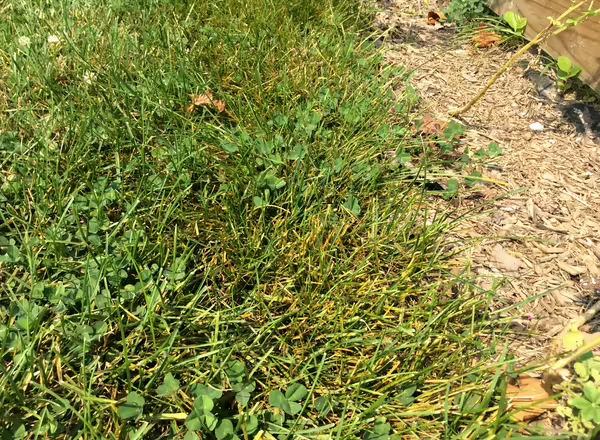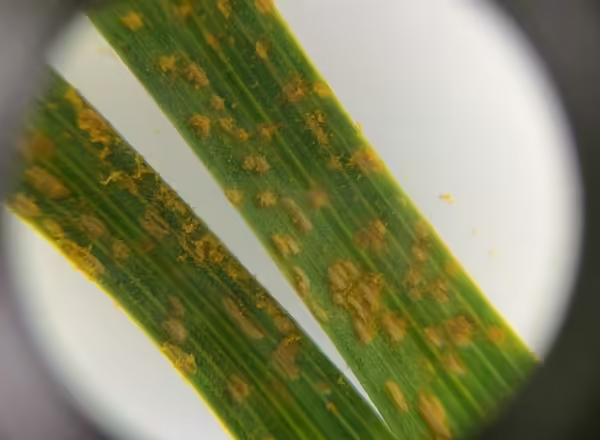
An orange lawn?
You’re walking through your lawn. You notice some discoloration in patches, but it doesn’t seem too alarming. After walking in your front door you begin to slip off your shoes and notice they’ve been turned an orange-red color. You’d swear it looked like your shoes were rusted-over.
It can almost be a guaranteed conversation in the late summer to early fall in Illinois. Homeowners call the Extension office with a strange substance on their shoes after walking through their lawn. This can be somewhat alarming, especially if you just bought new white sneakers. So what is this 'rusty' lawn disease? Here are some questions that usually come up in these conversations.
What is it?
The orange-red tint to your shoes and lawn are the fungal spores from a group of related fungi that cause the lawn disease rust. Kentucky bluegrass and perennial ryegrass are almost exclusively affected. Rust is more often found on lawns with a taller mowing height, yet it is mostly cosmetic.
Rust typically occurs in the late summer to early fall months. The disease is favored by dry soils and high humidity conditions, including long evening dew periods. Lawn rust typically develops later in the summer when cool-season lawns are growing very slowly.
Is it safe to walk on my lawn?
Yes, it is safe to walk on your lawn. Rust will not harm humans and is more of a visual nuisance than anything else. The fungal spores are easily detached and will cover just about anything that walks or moves over the lawn, including shoes, pets, and mowers.



How do I get rid of it?
There are a few cultural things you can do to reduce or eliminate rust from your lawn.
The easiest solution is to just wait until cooler weather. Once growing conditions become more favorable to cool-season lawn growth, we’ll mow off the rust and it will no longer be an issue.
Another option is to encourage lawn growth using fertilizers. Apply 1 pound of nitrogen fertilizer per 1,000 square feet. Rust is common on slow-growing grasses during dry stretches of weather. Nitrogen will stimulate your lawn to grow and surpass rust’s slow disease cycle. Applying nitrogen in the late summer to early fall is a good practice and is a recommended part of your cool season lawn routine.
Avoid irrigating during the evening. Evening watering prolongs the dew period, favoring rust development.
Hollow-core aerate when lawns are actively growing in the spring or fall. Rust can be more common on compacted soils. Aerating will relieve soil compaction.
There are species of turfgrass that are resistant to rust. Rehab your Kentucky bluegrass lawn into a tall fescue lawn. Kill off your lawn and reseed in rust-resistant turf-type tall fescue. Tall fescue is a popular pasture grass that has been bred by the turf industry to match common lawn grasses. Read more about turf-type tall fescue.
If you like your Kentucky bluegrass lawn, there are options for you. Turfgrass breeders are constantly improving genetics of their products. Overseed with new varieties of Kentucky bluegrass that are more resistant to rust.
Because lawn rust is mainly cosmetic, fungicides are only necessary if the homeowner demands a high-quality lawn. There’s no reason to spray another pesticide in the environment if we really don’t have to.
Sign up for our emails! Want to get notified when new Good Growing posts are available? SIGN ME UP
MEET THE AUTHOR
Chris Enroth is a horticulture educator with University of Illinois Extension, serving Henderson, McDonough, Knox, and Warren counties since 2012. Chris provides horticulture programming with an emphasis on the home gardener, landscape maintenance personnel, and commercial landscapers. Additional responsibilities include coordinating local county Master Gardener and Master Naturalist volunteers - providing their training, continuing education, advanced training, seasonal events, and organizing community outreach programs for horticulture and conservation assistance/education. In his spare time, Chris enjoys the outdoors, lounging in the garden among the flowers (weeds to most).